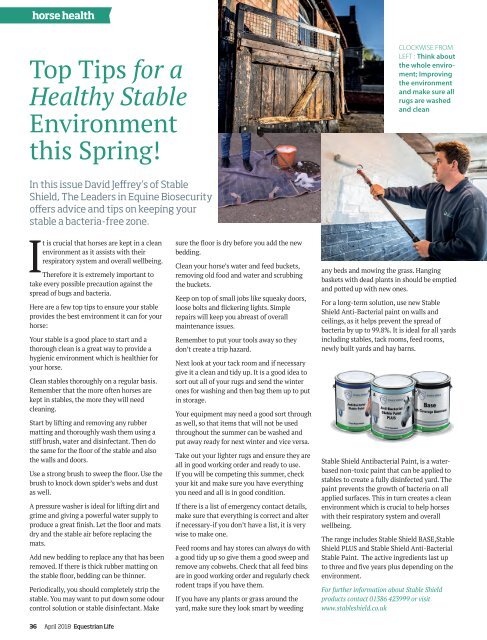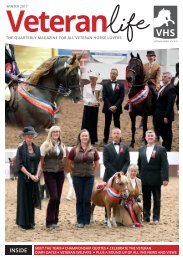Equestrian Life April 2018 Issue
Your leading monthly magazine for all horse lovers and riders
Your leading monthly magazine for all horse lovers and riders
Create successful ePaper yourself
Turn your PDF publications into a flip-book with our unique Google optimized e-Paper software.
horse health<br />
Top Tips for a<br />
Healthy Stable<br />
Environment<br />
this Spring!<br />
CLOCKWISE FROM<br />
LEFT : Think about<br />
the whole enviroment;<br />
Improving<br />
the environment<br />
and make sure all<br />
rugs are washed<br />
and clean<br />
In this issue David Jeffrey’s of Stable<br />
Shield, The Leaders in Equine Biosecurity<br />
offers advice and tips on keeping your<br />
stable a bacteria-free zone.<br />
It is crucial that horses are kept in a clean<br />
environment as it assists with their<br />
respiratory system and overall wellbeing.<br />
Therefore it is extremely important to<br />
take every possible precaution against the<br />
spread of bugs and bacteria.<br />
Here are a few top tips to ensure your stable<br />
provides the best environment it can for your<br />
horse:<br />
Your stable is a good place to start and a<br />
thorough clean is a great way to provide a<br />
hygienic environment which is healthier for<br />
your horse.<br />
Clean stables thoroughly on a regular basis.<br />
Remember that the more often horses are<br />
kept in stables, the more they will need<br />
cleaning.<br />
Start by lifting and removing any rubber<br />
matting and thoroughly wash them using a<br />
stiff brush, water and disinfectant. Then do<br />
the same for the floor of the stable and also<br />
the walls and doors.<br />
Use a strong brush to sweep the floor. Use the<br />
brush to knock down spider’s webs and dust<br />
as well.<br />
A pressure washer is ideal for lifting dirt and<br />
grime and giving a powerful water supply to<br />
produce a great finish. Let the floor and mats<br />
dry and the stable air before replacing the<br />
mats.<br />
Add new bedding to replace any that has been<br />
removed. If there is thick rubber matting on<br />
the stable floor, bedding can be thinner.<br />
Periodically, you should completely strip the<br />
stable. You may want to put down some odour<br />
control solution or stable disinfectant. Make<br />
sure the floor is dry before you add the new<br />
bedding.<br />
Clean your horse’s water and feed buckets,<br />
removing old food and water and scrubbing<br />
the buckets.<br />
Keep on top of small jobs like squeaky doors,<br />
loose bolts and flickering lights. Simple<br />
repairs will keep you abreast of overall<br />
maintenance issues.<br />
Remember to put your tools away so they<br />
don’t create a trip hazard.<br />
Next look at your tack room and if necessary<br />
give it a clean and tidy up. It is a good idea to<br />
sort out all of your rugs and send the winter<br />
ones for washing and then bag them up to put<br />
in storage.<br />
Your equipment may need a good sort through<br />
as well, so that items that will not be used<br />
throughout the summer can be washed and<br />
put away ready for next winter and vice versa.<br />
Take out your lighter rugs and ensure they are<br />
all in good working order and ready to use.<br />
If you will be competing this summer, check<br />
your kit and make sure you have everything<br />
you need and all is in good condition.<br />
If there is a list of emergency contact details,<br />
make sure that everything is correct and alter<br />
if necessary-if you don’t have a list, it is very<br />
wise to make one.<br />
Feed rooms and hay stores can always do with<br />
a good tidy up so give them a good sweep and<br />
remove any cobwebs. Check that all feed bins<br />
are in good working order and regularly check<br />
rodent traps if you have them.<br />
If you have any plants or grass around the<br />
yard, make sure they look smart by weeding<br />
any beds and mowing the grass. Hanging<br />
baskets with dead plants in should be emptied<br />
and potted up with new ones.<br />
For a long-term solution, use new Stable<br />
Shield Anti-Bacterial paint on walls and<br />
ceilings, as it helps prevent the spread of<br />
bacteria by up to 99.8%. It is ideal for all yards<br />
including stables, tack rooms, feed rooms,<br />
newly built yards and hay barns.<br />
Stable Shield Antibacterial Paint, is a waterbased<br />
non-toxic paint that can be applied to<br />
stables to create a fully disinfected yard. The<br />
paint prevents the growth of bacteria on all<br />
applied surfaces. This in turn creates a clean<br />
environment which is crucial to help horses<br />
with their respiratory system and overall<br />
wellbeing.<br />
The range includes Stable Shield BASE,Stable<br />
Shield PLUS and Stable Shield Anti-Bacterial<br />
Stable Paint. The active ingredients last up<br />
to three and five years plus depending on the<br />
environment.<br />
For further information about Stable Shield<br />
products contact 01386 423999 or visit<br />
www.stableshield.co.uk<br />
36 <strong>April</strong> <strong>2018</strong> <strong>Equestrian</strong> <strong>Life</strong>
















